
The moose hunt near Petersburg, Wrangell, and Kake opened Friday, Sept. 15. It’s a month-long hunt that includes several islands in central Southeast as well as some areas on the mainland.
The antler moose hunt allows hunters to take bull moose with certain antler configurations. There is no quota. The hunt liberalized in 2009 from requiring three brow tines on one side to allowing two brow tines on both sides.
Frank Robbins is the state wildlife biologist for the area. He says the hunt has been successful by all accounts. Over the last nine years, the harvest has been over 100 bulls.
He spoke with CoastAlaska’s Angela Denning about the upward harvest trend. He says moose are being harvested where they’ve never been before.
Hunters in Southeast are required to report many details of their hunt like their harvest location, the sex of the animal, and how many days they hunted.
Interview:
Robbins: We’re currently harvesting moose in areas where they weren’t harvested just 10-15 years ago. For example, Kuiu Island 10-12 years ago, there was a nominal harvest if any harvest at all. Last year, nearly 30 bulls were harvested Kuiu, it made up 25% of the total harvest. So it’s a dynamic situation, you know, there’s moose present in areas where they just weren’t present in the numbers that they are now.
Denning: That to me sounds like a good sign like the population could be expanding?
Robbins: I think that there’s a bit of an increase in the distribution of moves. And there’s been some good productivity. We don’t have a means by which we can estimate population. We manage largely on harvest and trends in harvest. And these these coastal rainforest areas it is very difficult to survey.
Denning: It’s just the trees and the mountains make it too dense to see from, say, an aerial survey.
Robbins: Right. We have some hopes they were experimenting with trail cameras now. We hope in the future, we’ll be able to adopt that technology. It’ll give us more information. But currently, we largely manage on harvest alone. That’s what our best at is. So, but yeah, you’re right, the moose harvest has increased over time, hunter success has increased. 15 years ago, higher success was around 11% for the time. 10 years later, it was up to about 14%. And now we’re 17% success, rate. So harvest is increased, hunter success is increased. So yeah, it looks good.
Denning: But you can’t definitively say that the population has increased, but you can say that is the distribution has increased.
Robbins: I don’t have data to present that demonstrates an increase in population. I have harvest data that shows that the harvest has increased, hunter’s success has increased and indirectly suggests that not only have we had an expansion in the distribution of the moose, but there’s more moose available. So they’ve been kind of moving of course from the mainland westward across the islands, across Kupreanof Island to Kuiu Island.
Denning: Any thoughts on the expansion? Is it just kind of a natural evolution?
Robbins: I’ve been told that is a natural expansion. That it’s just taking that long for moose to inhabit those areas since the glaciers receded. It’s just taking that much time for them to get there. Yeah. It’s not a topic that I’ve studied directly so I don’t know.
Denning: I’ve heard similarly, that traditionally the diet was more deer and moose was just hardly ever.
Robbins: That’s right, yeah. So I don’t remember exactly but I think maybe the first moose was sighted on Kupreanof in the 70s. So there’s just been a slow expansion of this distribution. So it’s an interesting dynamic, moose hunt.











